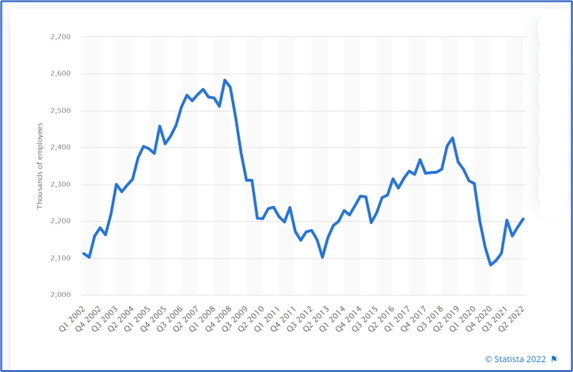September 2022 had the highest value of construction output (£15,125m) since 2010. While inflation has no doubt played its part, the prospect of rising order books has to be set against employment figures for the sector, which, as shown in the graph, have yet to return to anything near their 2019 levels.
 The Construction Industry Training Board’s (CITB’s) latest Construction Skills Network (CSN) report predicts that the UK construction industry will require an additional 226,000 workers by 2026.
The Construction Industry Training Board’s (CITB’s) latest Construction Skills Network (CSN) report predicts that the UK construction industry will require an additional 226,000 workers by 2026.
The exodus of workers during Covid, and the record high numbers of economically inactive (1.26 million vacancies in the UK) has led to an understandable perception that the employment market is now employee-led. Employers compete for talent by offering inducements, both financial and related to working conditions, such as hours, and location of work.
Any conversation with one of our operational clients will confirm this view, and the challenge facing the construction sector (and others) is:
How much can or should we change long-standing norms, practices, and policies to attract and retain people and are we sure that doing so will not damage productivity?
A major client recently explained how increased working from home and flexi-time arrangements for some indirect roles, such as quantity surveying (QS), buying and engineering, was affecting customer service as well as making it difficult to achieve schedule milestones. Granting a level of flexibility without fully examining the trade-offs and establishing new standards around basics such as e-mail response time and out of hours responses may make it more difficult to plan the need for different skill sets.
Two things exacerbate the problem. Firstly, the function that tends to lead the design of the new norms and policies (HR) is not directly accountable for the metrics that may suffer as a result. This is not to say that HR is oblivious to the issues, but its primary concern is finding people of the right calibre, whereas dealing with the productivity related fall-out of new ‘Ts and Cs’ usually falls elsewhere. Secondly, many roles still have no proper productivity-based metrics, instead relying on age-old industry norms such as man hours per tonne. These can be useful for estimating, but not for managing productivity.
The answer is to establish policies that balance the needs of the business to achieve results for its board, shareholders, and customers, with making it sufficiently attractive in the employment market. Businesses must avoid a recruitment and HR model that does not have sufficient regard to, and involvement with, operations and a detailed understanding of the trade-offs. In short, it is vital that a business considers how, by increasing employee flexibility, it may be restricting its own. It should take a considered and data-led approach to balancing priorities.
- One solution is to develop a clearly understood framework for productivity decision-making. This means undertaking a detailed study of the current state of productivity, the pain points, and their causes. This exercise is of inherent value to the business in any event and may lead to other initiatives and changes.
- Secondly, clarify the position of the core norms (the policy on hours, dress, location, remote work, start and finish times, out of hours contact, overtime, response times to e-mails, travel et cetera) and their link to productivity and performance. We must identify the relative value of working practices (this could be broadened to include attributes and attitudes) and how they affect productivity and performance.
HR-led policies that are good for recruitment but damaging operationally may still be the correct option if the trade-off creates a net benefit. It is also correct that operations may wish to set a series of non-negotiable norms for some roles, where transgressing them would be highly damaging. HR colleagues need to be made aware of these red lines to help guide their thoughts and processes.
As the industry moves with the times it must do so using a joined-up approach to finding, retaining, managing, and developing talent. The important point is to ensure there is a framework that prompts and shapes these discussions. Decision-making without such a tool for assessing the net position may lead to a one-sided and sub-optimal conversation.